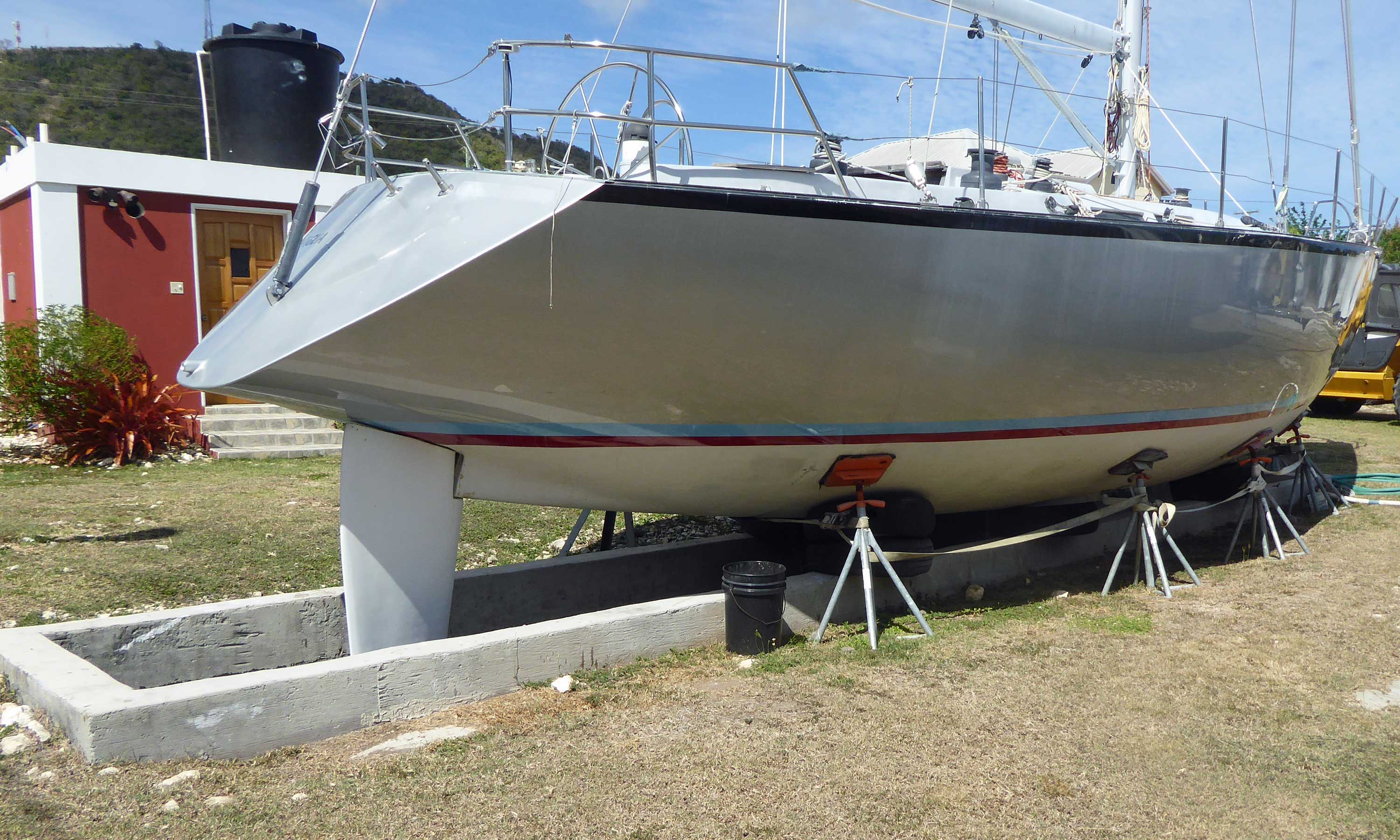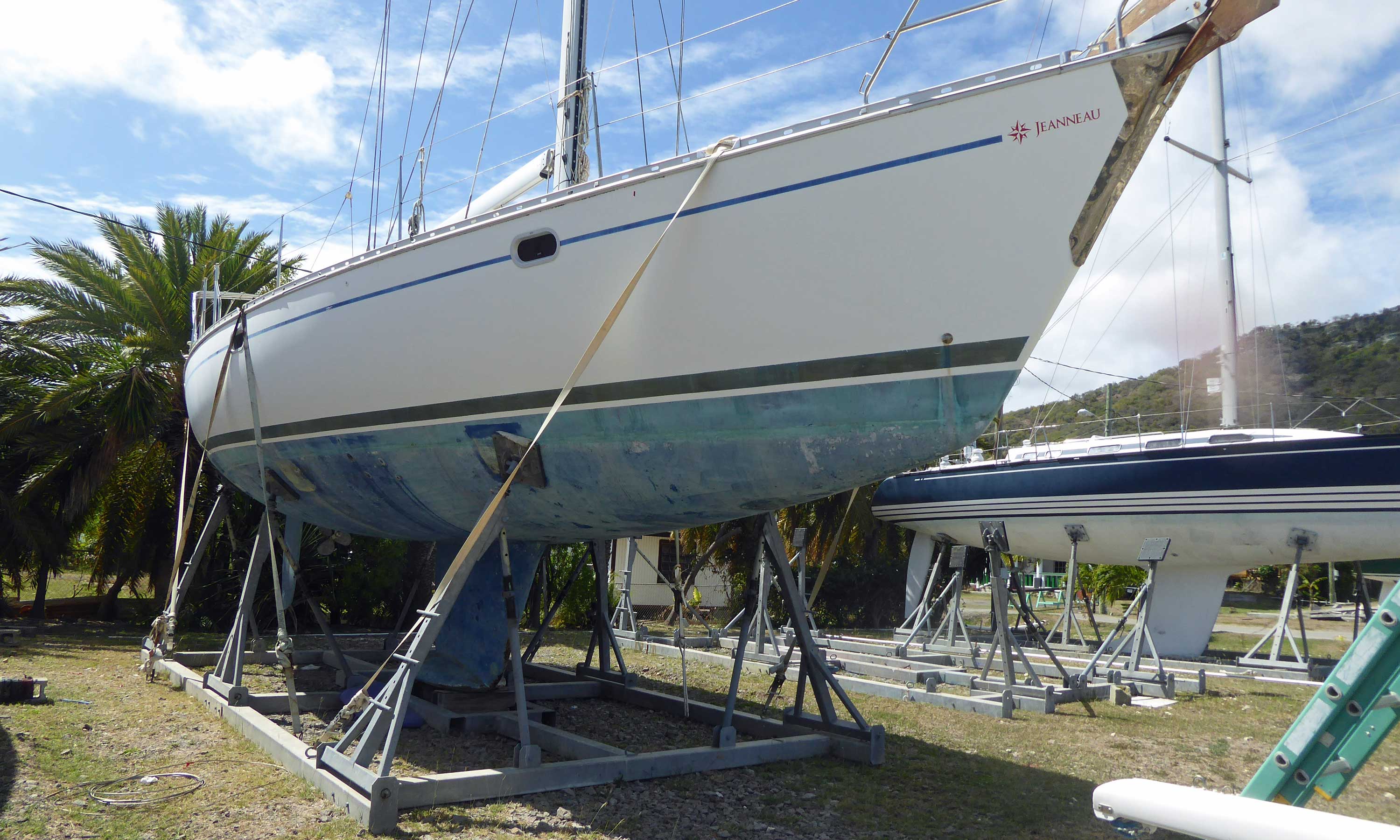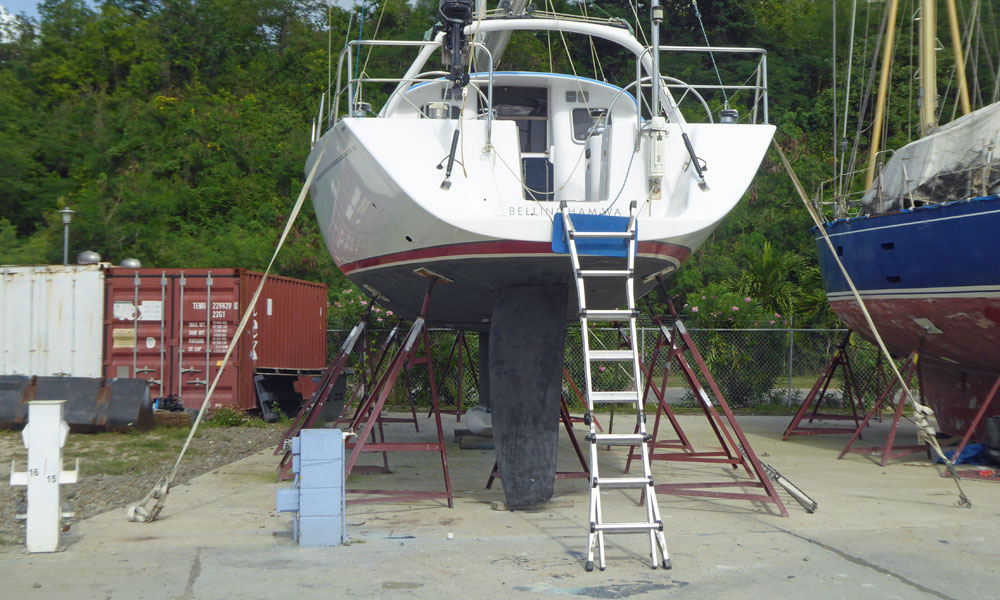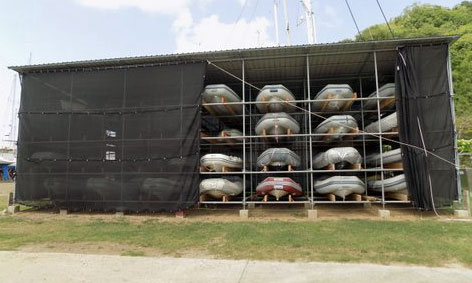- Home
- Sailing the Caribbean
- Caribbean Hurricane Season Boat Storage
Choosing a Boatyard for the Caribbean Hurricane Season
In a Nutshell...
Choosing the right boatyard for Caribbean hurricane season boat storage is a critical decision that balances safety, cost, and logistics. Your yacht insurance policy will largely dictate the acceptable methods, with most requiring onshore storage in a secured facility. Look for yards that use concrete pits, one-piece cradles, or welded-together boat stands and ensure they have a robust hurricane preparedness plan, including ground anchors and tie-downs. Beyond the technical specs, consider the boatyard's location for ease of travel, the services offered, and the total cost of storage. Doing your homework and asking the right questions will ensure you find a safe and suitable home for your boat through the storm season.
 One way of storing your boat through the Caribbean hurricane season - in a properly constructed concrete pit.
One way of storing your boat through the Caribbean hurricane season - in a properly constructed concrete pit.Table of Contents
For experienced ocean sailors, the approach of the Caribbean hurricane season, which runs from June 1st to November 30th, is a serious matter. We know that these powerful storms can be devastating. That’s why many of us choose to haul our boats out of the water and store them ashore, providing the best possible protection from the violent winds and storm surges.
This isn't just about peace of mind; it's a requirement. Following the tragic events of Category 5 Hurricane Ivan in Grenada back in 2004, most yacht insurance companies have become very specific about how and where you can store your vessel. Leaving a yacht afloat in a marina is often not a viable option. For most insurers, a boat must be "properly stored ashore," which typically means using a hurricane pit, a one-piece cradle, or securely welded-together boat stands.
So, with that in mind, how do you go about finding the right place for your boat?
 Another approach to securing your boat in preparation for the Caribbean hurricane season - in a substantial one-piece cradle, with tie-down straps.
Another approach to securing your boat in preparation for the Caribbean hurricane season - in a substantial one-piece cradle, with tie-down straps.The Three Critical Factors
When my wife Mary and I were looking for a hurricane storage facility for 'Alacazam' back in 2018, we narrowed our decision making criteria down to three main factors:
- The services available at the boatyard.
- The overall cost.
- The location and accessibility.
Let's dive into each of these.
1. Services & Security: What to Look For
You might think that hauling a boat out is all there is to it, but a top-tier boatyard will offer much more than just a lift. Here's a checklist of things you should be looking for:
- Secure Storage Method: As a minimum, the yard should use a secure support structure, such as steel cradles or tripod stands that are welded together to form a rigid, one-piece unit.
- Ground Conditions: Ideally, the hardstanding should be a properly drained concrete surface. You’ll really appreciate this when the rainy season hits and you don’t have to wade through mud to get to your boat.
- Ground Anchors & Tie-Downs: This is non-negotiable. Your insurance company will almost certainly require that your boat is strapped down to ground anchors. From my own experience as a victim of Hurricane Ivan, strapping down is an essential feature for a hurricane season lay-up.
Access & Facilities:
- Live-Aboard Policy: Do they allow you to live on the boat while it's on the hard? Many yards don't, especially in their long-term storage facilities.
- On-site Accommodation: Does the yard offer nearby rental accommodation? A place to stay while you're prepping the boat for haul-out or launch can be a lifesaver. Some yards, like Powerboats in Trinidad and Spice Island Marine in Grenada, have apartments available to rent right on site.
- DIY Work: Can you work on your own boat, or must you use their staff or a pre-approved contractor? Some yards charge a hefty daily fee for outside contractors.
2. The Cost of Storage
Comparing prices can be a little tricky because boatyards often have two separate elements to their costs:
- Fixed Costs: These include a one-off fee for lifting out, power-washing, and launching, as well as optional services like mast removal or cradle provision.
- Recurring Costs: This is the monthly or weekly storage fee for keeping your boat ashore.
Some yards will offer a very low monthly fee but hit you with high haul-out or launch charges. Always ask for the total, all-inclusive cost for the full period you plan to be ashore. And don't be afraid to negotiate. When I went through this process, the difference between the cheapest and most expensive option could have paid for our flights back to the UK. However, it's worth remembering that the cheapest doesn't always represent the best value.
Speaking of costs, you also need to understand your insurance policy's "Named Storm Deductible." This is a separate, often much higher, deductible that is triggered when damage is caused by any storm that has been given an official name by a meteorological service, such as the US National Hurricane Center. It’s a crucial detail that can significantly affect your out-of-pocket expenses if the worst happens. Many insurance companies specifically exclude liability for any loss or damage caused by a named storm.
3. Location, Location, Location
This factor often comes down to personal convenience. For us, the ability to get a direct flight from the UK was a major consideration.
- Martinique and Sint Maarten, for example, have great facilities, but require a flight change from the UK, which adds hassle and cost.
- Similarly, getting to Carriacou requires a ferry or inter-island flight from Grenada.
Our preferences quickly boiled down to a shortlist of islands with direct flights from London: Antigua, Grenada, St Lucia, and Trinidad. Finding the right location is just one piece of the puzzle for a successful cruise; you can find more information on cruising preparation in our comprehensive guide, "Sailing in the Caribbean: Information for Skippers & Crew".
The Inner Workings of a Top Caribbean Boatyard
To truly understand what goes into a professional hurricane storage operation, I spoke with Jo Lucas, General Manager of Jolly Harbour Marina & Boatyard in Antigua. Her insights were eye-opening and confirmed the importance of a well-executed plan.
She told me their approach goes far beyond just getting the boat out of the water. It’s a comprehensive strategy for protecting every vessel.
The Four Key Elements
- Support Structure: They use steel cradles or tripod stands. For stands, they are not only placed at critical points on the hull (ie, at the bulkheads) but are also mandatorily welded together longitudinally and transversely with rebar. This creates a single, rigid structure that's far more stable than individual stands.
- Ground Anchors: Movable concrete blocks are a no-go in their yard. Instead, they use "inverted mushrooms" of concrete poured into the ground beneath the hardstanding, or heavy-duty helical ground screws that are augured six feet deep. Both provide an unshakeable anchor point for tie-downs.
- Tie-Downs: A minimum of four hi-test industrial cargo straps are required per boat, with more used on larger vessels. They are all attached to the secure ground anchors.
- Hurricane Preparedness: As a storm approaches, the yard goes into an active countdown. They hold pre-hurricane meetings, check every boat, and secure any potential "missiles" like ladders or timber. They also take extensive photos before and after a storm for insurance purposes.
 Tripod stands (yet to be welded together with rebar) and tie-downs attached to ground anchors - almost ready to take on the coming hurricane season!
Tripod stands (yet to be welded together with rebar) and tie-downs attached to ground anchors - almost ready to take on the coming hurricane season!Additional Mandates at Jolly Harbour
- All sails, biminis, and other canvas must be removed.
- Dinghies are either deflated and stowed on deck or, in a unique and brilliant move, stored in a purpose-built scaffold shed. This keeps them safe and prevents them from becoming airborne missiles.
- Boats are strategically arranged by type to minimise a potential domino effect.
Mary and I ended up choosing Jolly Harbour, not just because they met all our requirements, but because their commitment to a belt-and-braces approach was second to none. The availability of a waterside apartment right near the yard was the icing on the cake, making the pre-haulout work and our time on the island much more enjoyable.
 Jolly Harbour's scaffold storage shed for 56 dinghies. During the hurricane season, each dinghy is secured to the scaffold and the entire structure is strapped down to ground anchors.
Jolly Harbour's scaffold storage shed for 56 dinghies. During the hurricane season, each dinghy is secured to the scaffold and the entire structure is strapped down to ground anchors.Preparing Your Boat for Storage Ashore
Before you lift your boat out, there's a lot of work to be done. A professional yard's services won't matter if you haven't done your part in preparing your vessel. Here's what an experienced sailor does to get the boat ready.
On Deck
- Strip it Down: Remove everything that could catch the wind. This means taking off all sails, including the mainsail and jib, and all canvas like biminis, dodgers, and spray hoods. These should be stored below deck or in a separate, dry storage locker.
- Clear the Clutter: Secure or remove all deck-level equipment. This includes outboard motors, gas bottles, and even your dinghy. As Jo Lucas told me, a dinghy can become an airborne missile in a storm, so deflating it and storing it below or in a secure shed is a must.
- Seal Everything: Close all seacocks and through-hulls to prevent rainwater from getting in. This also means taping over any vents and portholes that might leak.
Below Deck
- Combat the Humidity: The Caribbean is a hot and humid place, so mould and mildew are your enemy. Either run a dehumidifier for a few days before you leave and then turn it off, or place moisture-absorbing products like DampRid throughout the boat.
- Clean & Tidy: Give the boat a good cleaning. You'll thank yourself when you come back. Remove all food and rubbish, clean the bilges, and ensure all systems are shut down properly.
The Return: Post-Season Check-Up
When you get back to your boat after the season, don't rush to launch. Take your time and follow a methodical checklist to ensure everything is in order.
- Full Inspection: Carefully inspect the hull, keel, rudder, and rigging for any signs of damage. Even if the boat looks fine, a hairline crack or a pulled shroud can signal a serious problem.
- System Checks: Reconnect and test all your systems—engine, batteries, electronics, pumps—before you go back in the water.
- Document for Insurance: Take new photos of the boat and the boatyard. If you find any damage, document it immediately and contact your insurer.
This article was written by Dick McClary, RYA Yachtmaster and author of the RYA publications 'Offshore Sailing' and 'Fishing Afloat', member of The Yachting Journalists Association (YJA), and erstwhile member of the Ocean Cruising Club (OCC).
Summing Up
Opting for professional onshore storage in a well-equipped boatyard is the most effective way to protect your yacht and satisfy your insurer during the Caribbean hurricane season. The decision is more than just about cost; it’s about a comprehensive strategy that a top-tier boatyard employs to protect your valuable asset. Prioritise yards with proven, secure systems—like one-piece stands and ground anchors—and don't overlook practical factors like accessibility and on-site services. By doing your research and choosing wisely, you can secure your boat and enjoy peace of mind, knowing that you've done everything you can to keep her safe and secure while you're away.
FAQs
What are the official dates for the Caribbean hurricane season?
What are the official dates for the Caribbean hurricane season?
The official season runs from June 1st to November 30th each year.
Is it safe to leave my boat afloat in a marina during hurricane season?
Is it safe to leave my boat afloat in a marina during hurricane season?
Leaving a boat afloat is generally not recommended and is often against the requirements of most yacht insurance policies. Hauling the boat ashore is considered the safest option.
What is a "hurricane pit"?
What is a "hurricane pit"?
A hurricane pit is a large, purpose-built concrete trench where a boat is lowered. The keel sits securely in a slotted channel, and the hull is supported by the pit's walls, preventing the boat from being toppled by high winds.
Do I have to live on the boat while it's in the boatyard?
Do I have to live on the boat while it's in the boatyard?
Not necessarily. Many boatyards, especially those with long-term storage, do not permit live-aboards. It's best to check with the yard beforehand and consider nearby short-term accommodation.
How do I find a boatyard that meets my insurer's requirements?
How do I find a boatyard that meets my insurer's requirements?
Start by asking your insurance provider for their specific requirements regarding hurricane storage. They will be able to tell you the acceptable methods and might even provide a list of pre-approved yards.
Recent Articles
-
Beneteau Oceanis 400: Expert Review, Specs & Performance Analysis
Jan 12, 26 07:40 AM
A comprehensive guide to the Beneteau Oceanis 400 sailboat. We analyse the Jean-Marie Finot design, performance ratios, interior layouts, and offshore cruising capabilities for prospective buyers. -
Hunter Passage 42 Sailboat: Specs, Performance & Cruising Analysis
Jan 11, 26 05:31 AM
Explore the Hunter Passage 42 sailboat. Includes detailed design ratios, performance analysis, interior layout review, and expert cruising advice for owners. -
Ohlson 38 Guide: Specs, Performance Analysis & Cruising Review
Jan 07, 26 05:52 AM
Discover the Ohlson 38 sailboat. An in-depth look at its Einar Ohlson design, Tyler GRP construction, performance ratios, and why it remains a top choice for offshore sailors.












